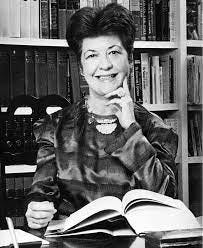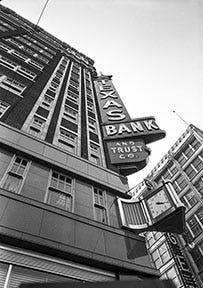The building is a run-of-the-mill, 1950s bank building. The largest tenant, Texas Bank & Trust, had a six-story vertical sign riding on one corner over a large, three-sided clock. Walking in and out of a building every workday for three years, it all blends into a blur. The same doorway, the same hall ashtray, the same elevator door, the same glass windows. Nothing to strike the imagination. It becomes so common that you don’t notice any of it.
However, on her third holiday season at the bank, Bette stood outside the big plate glass windows watching sign painters put the finishing touches on the Christmas window scenes. When she was young, she wanted to be a painter. Her mother taught her how to paint with oils. But now at age 30 she knew too well that she could not support herself through art. She lived alone with her son, Michael. He would turn 12 right after Christmas.
Bette Nesmith had been working as an executive secretary at the Texas Bank & Trust for three years. This was her first steady job since her 1946 divorce. She wasn’t a very good typist, but she compensated through hard work and diligence. But now the manual typewriters she had learned on were being replaced by electric typewriters. And she feared that she would be replaced, too.
Electric typewriters were fast, trigger happy— each letter responded to the slightest touch. Mistakes were multiplied. The new typewriters used carbon ribbons rather than cloth. When she tried to correct a typo, the eraser she had always used smeared the paper. She had to retype the document from the start.
Watching the sign painters on that December lunch hour, she noticed that their mistakes were simply covered up with more paint. She remembered how her mother taught her to paint over mistakes on an oil canvas. So, she bought a small bottle of white, water-based tempera paint. She trimmed a small water-color brush. The next day she began brushing out her typos. Her bosses didn’t notice.
But soon other secretaries began to ask for their own bottles.
Nesmith began staying up late whipping up white-colored paint in her kitchen blender using a plastic ketchup dispenser with a funnel spout to insert the liquid into empty nail polish bottles.
Soon she hired her first employees: her son Michael and his teenage friends. They converted the kitchen into a small packaging plant. For a dollar an hour, they squeezed the concoction into nail polish bottles, applied labels by hand, and trimmed the brush tips inside the cap at an angle.
Bette began making “Mistake Out” in 1954. By 1957, she was selling 100 bottles a month. She changed the name to “Liquid Paper.” She tried to interest office supply wholesalers and typewriter manufacturers. She sent two copies of the same letter to IBM—one with typos corrected with an eraser and one with typos rendered invisible by “Liquid Paper.”
Her cover letter exuded confidence and optimism:
I truly believe that this can mean a turning point from the old methods – a new era.
IBM was not interested. As she had been since her first husband went off to war in 1941, she was on her own. She said later:
I felt very inadequate. I didn’t know how I was going to do it. The problems seemed insurmountable, but I saw this challenge that I was to meet.
Then she made a mistake. In 1958, rather than sign a letter for her boss with Texas Bank & Trust, she signed “The Mistake Out Company” on Bank stationery. She had risen to the highest position available to a woman at the bank —executive secretary. And now she was fired for one mistake.
The financial pressures that had long haunted her seemed about to derail her. Her son Michael recalled that she would often “burst into tears of panic.” Fear became a dominant emotion in her life.
Despite her fear and doubts, she somehow knew that Liquid Paper was her only hope. She returned to tinkering with the recipe. She wanted the product to be perfect. But she had no money to hire experts. She grabbed information wherever she could, consulting her son’s high school chemistry teacher and a local paint-shop employee.
Bette Nesmith visited office supply wholesalers in Texas only to be rejected. She sold handfuls of bottles to area office supply stores. In 1958, she purchased an ad in The Secretary, a national trade magazine. The Secretary called Liquid Paper “the answer to a secretary’s prayers.” The General Electric Company, which had spurned her earlier, placed an order for 400 bottles in three colors. Large businesses followed soon including the recalcitrant IBM.
Although her business was finally taking shape, her fears remained, as she explained in an interview years later:
I think anyone who is making progress faces fear. Overcoming fear is all there is to success. You have to face fears and doubts constantly. You keep doing it over and over.
Bette Nesmith’s home-grown manufacturing operation was expanding beyond her kitchen. Or as she referred to the kitchen in business correspondence: the company’s research and development laboratory. Liquid Paper manufacturing was moved into the garage, and then to a trailer parked in her back yard and later to a four-room house.
In 1962, Bette married a frozen food salesman, Robert Graham. He entered the company as an executive and spurred the company to further growth. The company registered its first profitable year in 1964, selling more than 5,000 bottles per week.
In 1968, she sold one million bottles and left behind the four-room house. Liquid Paper established its own factory with automated operations, corporate headquarters, and 19 full-time employees. Seven years later, Liquid Paper moved into a 35,000-square-foot international headquarters building in Dallas.
In 1958, Mistake Out was mixed by hand and squeezed from plastic ketchup bottles. In 1976, the new plant produced 500 bottles a minute, 25 million bottles in one year and spent $1 million on advertising.
Bette was a faithful Christian. She understood the burdens of working women, and she wanted to make her company welcoming and supportive. She made Liquid Paper one of the first companies in the U.S. to offer:
· On-site childcare facilities
· An employee-owned credit union
· Wheelchair-accessible facilities
· Tuition reimbursement
· A racially integrated staff
· Support for affirmative action policies
***
Her second husband, Robert Graham, had been instrumental in the company’s steady growth. But he became greedy in 1975. As chairman of board, he tried to force Bette out. She was excluded from corporate decisions and banned from setting foot on company premises. Robert Graham ordered changes in the Liquid Paper formula in a bid to deny Bette royalties.
Bette fought back. She divorced Robert and finally emerged from the turmoil of bitter acrimony vindicated and in control of her company.
To celebrate her victory and her company’s domination of the correction fluid business, Bette bought a Rolls Royce and jewelry. In 1977, she established the Gihon Foundation to collect paintings and artwork by women. (Gihon is from Genesis, one of four rivers gushing from the Garden of Eden as a symbol of ever flowing abundance.) She followed one year later with the Bette Clair McMurray Foundation in support of women in need—as she had once been.
In 1979, Bette sold her company to Gillette for $47.5 million. She died less than a year later.
Bette Nesmith’s idea was sparked by watching a mundane activity—painting plate glass windows—in a setting she knew well. She had not only seen this before, but she had also done it herself—one of the many temporary jobs she took to scrape by as a single mother. She made a connection between painting ads on glass and the painting techniques she learned from her mother. Combining a memory and an insight, she solved a personal work problem. As fellow secretaries coveted her system, she saw a business opportunity which she pursued relentlessly in spite of her nagging fears. She said:
Persistence is like courage. Either you have it or you don’t. But it is the willingness to have it, the wanting to have it that makes it possible. You have to want it more than anything else.
She left her estate to her only child, Michael Nesmith, who was a member of the pop-rock band The Monkees.
Bette Nesmith was high school dropout, a single mother, and eventually a business magnate. She described herself as a:
feminist who wants freedom for myself and everybody else…I had to appreciate that as a woman I was strong, complete, adequate.
******
Dan Hunter’s book, Learning and Teaching Creativity, is available from
https://itascabooks.com/products/learning-and-teaching-creativity-you-can-only-imagine
Teachers receive a 20% discount.
Audiobook is available at
https://www.audible.com/pd/Learning-and-Teaching-Creativity-Audiobook/B0CK4BQDJP






Dear Debi,
Thank you for reading and commenting. I remember you well,
Best wishes,
Dan
Thank you for that, an inspiring story!!!
Debi Dickinson, yes thst one!!!